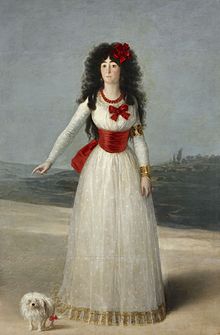María Cayetana de Silva, 13th Duchess of Alba
María Teresa de Silva | |
|---|---|
| Duchess of Alba | |
 The White Duchess by Goya, 1795 | |
| Full name | María del Pilar Teresa Cayetana de Silva y Silva-Bazán |
| Born | 10 June 1762 Madrid, Spain |
| Died | 23 July 1802 (aged 40) Sanlúcar la Mayor, Andalusia, Spain |
| Noble family | House of Silva House of Alba |
| Spouse(s) | José Álvarez de Toledo Osorio, 11th Marquess of Villafranca |
| Issue | María de la Luz (adopted) |
| Father | Francisco de Silva y Álvarez de Toledo, 10th Duke of Huéscar |
| Mother | Mariana de Silva-Bazán y Sarmiento |
María del Pilar Teresa Cayetana de Silva y Silva-Bazán, 13th Duchess of Alba, GE (10 June 1762 – 23 July 1802), was a Spanish aristocrat and a popular subject of the painter Francisco de Goya.
Biography

María del Pilar Teresa Cayetana de Silva became the 13th Duchess of Alba in 1776 after inheriting the title from her paternal grandfather, Fernando de Silva, 12th Duke of Alba, who outlived her father. Her marriage the year before to José Álvarez de Toledo Osorio, 11th Marquess of Villafranca (a male-line descendant of Fadrique Álvarez de Toledo, 2nd Duke of Alba), made her and her husband the wealthiest couple in the Kingdom of Spain. Their only rivals to this status were the House of Osuna.
The duchess' relationship with famed Spanish painter Francisco de Goya and her somewhat eccentric personality have contributed greatly to a continuing interest in her life during the two centuries since her death. Goya executed several well-known portraits of the duchess, most of them during his stay at Sanlúcar de Barrameda (one of the Andalusian country seats of the House of Medina Sidonia) shortly after the death in 1796 of her husband, who was also the 15th Duke of Medina Sidonia.
Goya's accompaniment of the recently widowed duchess, combined with certain innuendo expressed in his portraits of her, have exacerbated rumors that the two were lovers.[1] Although this has never been confirmed, the large number of portraits that the artist painted of the duchess suggests, at the very least, a close platonic relationship between the two.
The painting La maja desnuda, executed between 1797 and 1800 by Goya, has also been rumored to portray her. The painting, considered scandalous by Spanish society of the time, depicts a fully nude reclining woman. It, together with a companion piece depicting the same model clothed (La maja vestida), was commissioned by Spanish prime minister Manuel Godoy (the known lover of Spain's queen, María Luisa).
The true identity of the majas is uncertain. Many art historians over the years have rejected the possibility that the painting depicts the duchess, including Australian art critic Robert Hughes in his 2003 biography, Goya. Those scholars believe that the painting depicts either Godoy's young mistress, Pepita Tudó, or an idealized composite of several different models.[2]
Death and succession
The duchess died under somewhat mysterious circumstances in July 1802 at the age of 40. Although her death was ostensibly due to tuberculosis and a fever, more colorful scenarios have been suggested over the years, among them a theory that she was poisoned (this theory was dramatized in the film The Naked Maja). She had no biological children, although she did have an adoptive daughter, known as María de la Luz.
After her death, the Alba ducal title passed to a relative, Carlos Miguel Fitz-James Stuart (1794–1835), who became the 14th Duke of Alba.
Ancestry
| Ancestors of María del Pilar de Silva, 13th Duchess of Alba | ||||||||||||||||||||||||||||||||||||||||||||||||||||||||||||||||||||||||||||||||||||||||||||||||||||||||||||||||||||||||||||||||||||||||||||||||||||||||||||||||||||||||||||||||||||||||||||||||||||||||||||||||||||||||||||||||||||||||||||||||||||||||||||||||||||||||||||||||||||||||||||||||||||||||||||||||||||||||||||||||||||||||||||||||||||||||||||||||||||||||||||||||||||||||||||||||||||||||||||||||||||||||||||||||||||||||||||||||||||||||||||||||||||||||||||||||||||||||||||||||||||||||||||||||||||||||||||||||||||||||||||||||||||||||||||||||||||||||||||||||||||||||||||||||||||||||||||||||
|---|---|---|---|---|---|---|---|---|---|---|---|---|---|---|---|---|---|---|---|---|---|---|---|---|---|---|---|---|---|---|---|---|---|---|---|---|---|---|---|---|---|---|---|---|---|---|---|---|---|---|---|---|---|---|---|---|---|---|---|---|---|---|---|---|---|---|---|---|---|---|---|---|---|---|---|---|---|---|---|---|---|---|---|---|---|---|---|---|---|---|---|---|---|---|---|---|---|---|---|---|---|---|---|---|---|---|---|---|---|---|---|---|---|---|---|---|---|---|---|---|---|---|---|---|---|---|---|---|---|---|---|---|---|---|---|---|---|---|---|---|---|---|---|---|---|---|---|---|---|---|---|---|---|---|---|---|---|---|---|---|---|---|---|---|---|---|---|---|---|---|---|---|---|---|---|---|---|---|---|---|---|---|---|---|---|---|---|---|---|---|---|---|---|---|---|---|---|---|---|---|---|---|---|---|---|---|---|---|---|---|---|---|---|---|---|---|---|---|---|---|---|---|---|---|---|---|---|---|---|---|---|---|---|---|---|---|---|---|---|---|---|---|---|---|---|---|---|---|---|---|---|---|---|---|---|---|---|---|---|---|---|---|---|---|---|---|---|---|---|---|---|---|---|---|---|---|---|---|---|---|---|---|---|---|---|---|---|---|---|---|---|---|---|---|---|---|---|---|---|---|---|---|---|---|---|---|---|---|---|---|---|---|---|---|---|---|---|---|---|---|---|---|---|---|---|---|---|---|---|---|---|---|---|---|---|---|---|---|---|---|---|---|---|---|---|---|---|---|---|---|---|---|---|---|---|---|---|---|---|---|---|---|---|---|---|---|---|---|---|---|---|---|---|---|---|---|---|---|---|---|---|---|---|---|---|---|---|---|---|---|---|---|---|---|---|---|---|---|---|---|---|---|---|---|---|---|---|---|---|---|---|---|---|---|---|---|---|---|---|---|---|---|---|---|---|---|---|---|---|---|---|---|---|---|---|---|---|---|---|---|---|---|---|---|---|---|---|---|---|---|---|---|---|---|---|---|---|---|---|---|---|---|---|---|---|---|---|---|---|---|---|---|---|---|---|---|---|---|---|---|---|---|---|---|---|---|---|---|---|---|---|---|---|---|---|---|---|---|---|---|---|---|---|---|---|---|---|---|---|---|---|---|---|---|---|---|---|---|---|---|---|---|---|---|---|---|---|---|---|---|---|---|---|---|---|---|---|---|---|---|---|---|---|---|---|---|---|---|---|---|---|---|---|---|---|---|---|---|---|---|---|---|---|---|---|---|---|---|---|---|---|---|---|---|---|---|---|---|---|---|---|---|---|---|---|---|---|---|---|---|---|---|
| ||||||||||||||||||||||||||||||||||||||||||||||||||||||||||||||||||||||||||||||||||||||||||||||||||||||||||||||||||||||||||||||||||||||||||||||||||||||||||||||||||||||||||||||||||||||||||||||||||||||||||||||||||||||||||||||||||||||||||||||||||||||||||||||||||||||||||||||||||||||||||||||||||||||||||||||||||||||||||||||||||||||||||||||||||||||||||||||||||||||||||||||||||||||||||||||||||||||||||||||||||||||||||||||||||||||||||||||||||||||||||||||||||||||||||||||||||||||||||||||||||||||||||||||||||||||||||||||||||||||||||||||||||||||||||||||||||||||||||||||||||||||||||||||||||||||||||||||||
Images by Francisco de Goya
-
The Duchess and la Beata (1795)
-
The Duchess arranging her hair
Doubted to represent the duchess
References
- ^ http://eeweems.com/goya/duchess_black.html
- ^ The Clothed Maja and the Nude Maja, the Prado Archived 2007-10-12 at the Wayback Machine Retrieved 27 July 2007
Sources
- Hobbs, Nicolas (2007). "Grandes de España" (in Spanish). Archived from the original on 2006-11-29. Retrieved 15 October 2008.
- Instituto de Salazar y Castro. Elenco de Grandezas y Titulos Nobiliarios Españoles (in Spanish). periodic publication.




